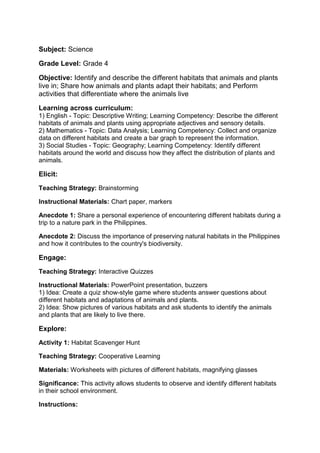
lesson_plan.docx
- 1. Subject: Science Grade Level: Grade 4 Objective: Identify and describe the different habitats that animals and plants live in; Share how animals and plants adapt their habitats; and Perform activities that differentiate where the animals live Learning across curriculum: 1) English - Topic: Descriptive Writing; Learning Competency: Describe the different habitats of animals and plants using appropriate adjectives and sensory details. 2) Mathematics - Topic: Data Analysis; Learning Competency: Collect and organize data on different habitats and create a bar graph to represent the information. 3) Social Studies - Topic: Geography; Learning Competency: Identify different habitats around the world and discuss how they affect the distribution of plants and animals. Elicit: Teaching Strategy: Brainstorming Instructional Materials: Chart paper, markers Anecdote 1: Share a personal experience of encountering different habitats during a trip to a nature park in the Philippines. Anecdote 2: Discuss the importance of preserving natural habitats in the Philippines and how it contributes to the country's biodiversity. Engage: Teaching Strategy: Interactive Quizzes Instructional Materials: PowerPoint presentation, buzzers 1) Idea: Create a quiz show-style game where students answer questions about different habitats and adaptations of animals and plants. 2) Idea: Show pictures of various habitats and ask students to identify the animals and plants that are likely to live there. Explore: Activity 1: Habitat Scavenger Hunt Teaching Strategy: Cooperative Learning Materials: Worksheets with pictures of different habitats, magnifying glasses Significance: This activity allows students to observe and identify different habitats in their school environment. Instructions:
- 2. 1) Divide students into small groups. 2) Give each group a worksheet with pictures of different habitats. 3) Instruct students to explore the school premises and find examples of each habitat. 4) Encourage students to use magnifying glasses to observe plants and animals in each habitat. Rubric: - Correctly identified habitats: 5 pts. - Accurate descriptions of plants and animals in each habitat: 5 pts. Assessment Questions1) What is a habitat? 2) How do plants and animals adapt to their habitats? 3) Give an example of a plant and an animal that live in the same habitat. Activity 2: Habitat Diorama Teaching Strategy Project-Based Learning Materials: Shoeboxes, art supplies, toy animals and plants Significance: This activity allows students to create a 3D representation of a habitat and showcase understanding of how animals and plants adapt their environment. Instructions: 1) Assign each student or group a specific habitat (e.g., forest, desert, ocean). 2) Provide shoeboxes and art supplies for students to create their diorama. 3) Instruct students to include appropriate plants and animals in their diorama and explain how they adapt to their habitat. Rubric: - Accuracy of habitat representation: 5 pts. - Creativity and attention to detail: 5 pts. Assessment Questions: 1) What did you learn about the habitat you chose while creating your diorama? 2) How did you decide plants and animals to include in your diorama? 3) Explain one adaptation of an animal in your diorama. Activity 3: Habitat Comparison Teaching Strategy: Inquiry-Based Learning Materials: Venn diagram worksheets, pictures of different habitats Significance: This activity allows students to compare and contrast different habitats and identify similarities and differences in the adaptations of plants and animals. Instructions: 1) Distribute Venn diagram worksheets to students. 2) Show pictures of two different habitats and discuss their characteristics. 3) Instruct students to complete the Venn diagram by listing the similarities and differences between the two habitats.
- 3. Rubric: - Accurate identification of similarities and differences: 5 pts. - Clear and logical organization of information: 5 pts. Assessment Questions: 1) What are some similarities between the two habitats you compared? 2) How are the adaptations of plants and animals in the two habitats different? 3) Why is it important for plants and animals to adapt to their habitats? Explain: Teaching Strategy: Lecture and Discussion Provide examples and explanations of different habitats and how plants and animals adapt to them. Encourage students to ask questions and participate in discussions to deepen their understanding. Elaborate: Teaching Strategy: Experiential Learning Task 1: Students will create a mini-ecosystem in a jar using soil, plants, and small animals. They will observe the interactions between the organisms and discuss how they are adapted to their habitat. Task 2: Students will research and create a poster or presentation about a specific animal and its habitat. They will explain the adaptations of the animal and discuss the importance of preserving its habitat. Evaluate: Teaching Strategy: Games and Gamification Instructional Materials: Quiz cards, game board Question 1: Which habitat is characterized by high temperatures and very little rainfall? Question 2: How do animals adapt to a cold climate? Question 3: Name two plants that are commonly found in wetland habitats. Extend: Teaching Strategy: Case Studies Instructional Materials: Case study scenarios related to different habitats Present case studies that require students to apply their knowledge of habitats and adaptations to solve real-life problems, such as preserving a threatened habitat or reintroducing a species into its natural habitat. Assignment:
- 4. Assignment 1: Write a descriptive paragraph about your favorite habitat and the plants and animals that live there. Use appropriate adjectives and sensory details. Assignment 2: Create a concept map showing the interrelationships between different habitats, plants, and animals. Include examples of adaptations for each habitat. Note: The teacher can modify the lesson plan according to the available resources and time constraints.